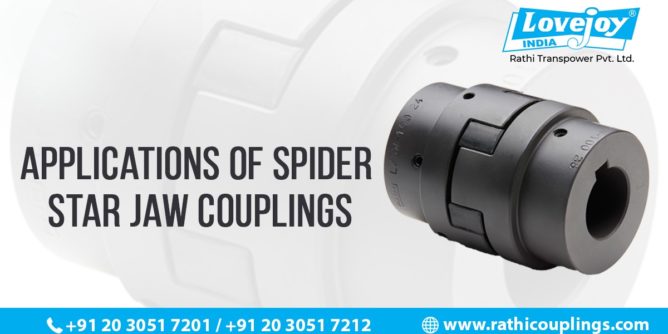
Why a Jaw Coupling?
Rathi Lovejoy first began assembling their signature straight jaw couplings in the late 1965’s and today, Rathi Lovejoy keeps on dispatching a huge number of jaw couplings consistently.
What makes the jaw coupling so useful and timeless that it keeps on being as relevant today?
As a matter of first importance, jaw couplings are well known because they are flexible and strong. They make for an incredible general universally industrial power transmission coupling.
They work in a wide band of temperatures, can deal with precise misalignment, can deal with reactionary loads because of misalignment, have great torque to outside diameter capability and have great speed ability, great chemical resistance and average dampening capacity.
They are simple and straight forward to install. An essential jaw coupling is contained just 3 principle parts, two hubs and an elastomeric spider. Jaw couplings are ubiquitous and low cost in relative to other alternatives.
Jaw couplings are safeguarded. While you ought to occasionally check your jaw coupling spiders for wear and supplant them definitely, somebody will neglect to check or service a jaw coupling and the spider will wear out or fall.
For this situation, the coupling hubs will interlock and keep conveying the load. Hub on hub activity without a spider is amazingly imperfect and not suggested for preceded with system use.
Additional Benefits of Jaw Couplings
In addition to jaw couplings being considered safeguard and the various advantages previously talked about above, jaw couplings are likewise viewed as maintenance- free as they require no lubrication.
Unlike gear, grid or chain couplings that require intermittent reapplication of grease. As long as the spider remains intact, a jaw coupling will keep on working.
Jaw couplings, in their conventional structure, transmit their torque through the elastomeric flexing component in pressure.
From an elastomeric component point of view, this is best for torque transmission since elastomers can take considerably more discipline and burden in pressure.
The jaw coupling has been acknowledged as the bread and butter of modern couplings, spreading far and wide.
The last but not the least advantage of the structure is that there are currently a colossal number of jaw coupling varieties available for pretty much every industry you can imagine giving gigantic design, flexibility for equipment designers and support engineers alike.
Read More:Why Lovejoy Couplings should be your First Choice
Hub Design Basics
Standard jaw couplings contain two centre hubs and an elastomeric spider. The hubs generally bored to a clearance fit tolerance with a solitary keyway and set screw to enable quick installation.
The standard straight jaw hub material for little to mid-run sizes is powder metal. Powder metallurgy is the process of blending, compacting and warming extremely fine metal particles.
The benefit of forming the hubs points along these lines is that they can be pressed extremely near completed net shape, limiting the time and expenses of machining just as virtually eliminating scrap.
Powder metallurgy is a demonstrated innovation that Rathi Lovejoy and others in the field have been utilizing for quite a long time.
Bigger standard jaw hubs are manufactured out of cast iron, which is additionally a demonstrated developed innovation, as this innovation is more cost effective for the given sizes and amounts found in this item extend.
Read More: Various Applications of Couplings
Spider (Elastomers) Design Basics
The most standard fundamental jaw coupling spider is a spider constructed of solid Nitrile Butadiene (Buna N), rubber (pictured at left).
This flexible elastomeric is oil resistant, resembles natural rubber in resilience and elasticity and operates effectively in a temperature range of -40° to 212° F (-40° to 100° C).
This rubber is well suited for cyclic loads. Broadly speaking, this spider generally has a shore hardness of 80A, high dampening capacity and good chemical resistance.
Another popular variation of the Nitrile Butadiene (Buna N) rubber spider is the open centre option.
While the closed centre version is a more robust design and more desirable particularly for higher speed applications, the closed centre does not allow for extremely close (near touching) shaft separation.
Simply put, the open centre spider is designed primarily for applications where the between shaft ends (BSE) distance is very tight and there is no room for
Hytrel® spiders is designed for high torque and high-temperature operations (-60° to 250° F, -51° to 121 C) and has excellent resistance to oil and chemicals.
It is not recommended for cyclic or start/stop applications and is also generally limited to a half degree of angular misalignment. Parallel misalignment handling ability does remain similar to Buna N & Urethane spiders at approximately 0.015 inches.
Bronze spiders are rigid, porous oil-impregnated metal inserts that are designed exclusively for slow speed applications (max 250 RPM) that require high torque capabilities.
These spiders are largely not affected by extreme temperatures (-40° to 450° F, -40° to 232 C), water, oil, or dirt. Angular misalignment capability is similar to Hytrel® but parallel misalignment handling is reduced to 0.010 inches
Rathi couplings are the best coupling manufacturer, manufacturing some of the best spider star jaw couplings and elastomeric couplings.
